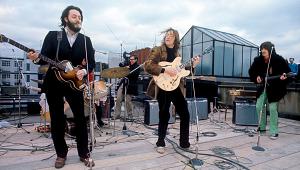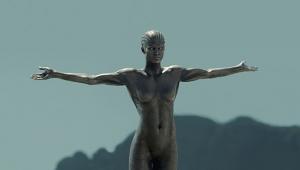The World of Raised by Wolves - A Behind-the-Scenes Look Page 4
The sun logo — for their god, Sol — seen on the Mithraics' uniforms, was another Ridley Scott concoction, drawn from a clock he owns. They also wear brass medallions from their necks, featuring the symbol. "We actually cast those — made a lot of them," Seagers states, taking advantage of the much-lower costs of nearly everything in South Africa. "We didn't have the budget we normally would have. So when you have an appetite like Ridley's, that worked out well."
The Ark's fate is sealed, unfortunately, when Mother takes the visiting Mithraics' Lander up to the ship, collects some children, and, after killing whomever else she meets, programs the ship to crash into the planet before she returns to the surface.
The crash of such a massive vessel is, of course, horrific to behold, though it is handled with gracious care, both by the visual effects team and sound team. The ship (by VFX house Pixomondo) passes quietly overhead above one young character, before exploding in an atypical collection of magenta and blue light (crafted by another VFX house, Mr. X) and with a thoroughly unsettling distant rumble.
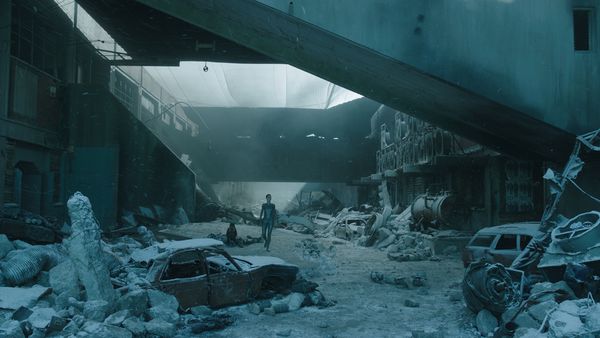
"Ridley didn't want to see the typical orange fireball, like we see today — because the power source would be something we don't know about, something that would exist 100 years from now," explains Ray McIntyre. "He said, 'We don't know what the power source would be in the future.'"
Similarly, the sound design eerily portrays the massive size of the crash. "We really laid it back," says Ron Eng. "When it goes overhead, it's pretty big, but not like you'd think, because it's so huge. And as it passes, and you see the explosion in the distance as it hits a mountain, we put a lot in the boom channel of the surround, so it shakes the room."
One of the most remarkable sights and pieces of art direction for the series is the Ark wreckage itself, appearing not simply as a scattered field of miscellaneous debris, but with various chunks/sections seen for miles. Explains, McIntyre, "Ridley said that this ship is massive. And when it would hit, it wasn't colliding into the side of a mountain and, boom, it's done. It was hitting a valley on the other side of that mountain. He said, 'It could hit that valley and break up and scrape along the planet for 10 miles. There's a piece of wreckage here, and then a different looking piece of wreckage in a different place.' It left different pieces of itself as it trenched through the environment," leaving something unique for characters to discover and interact with in different places.
"Every time you encounter one of these pieces," says Guzikowski, "it's a discovery. It creates all these interesting opportunities." Mother, for example, finds a section with a functioning SIM pod, allowing her to connect and explore her own history.
Its overall, very detailed design and construction is what is amazing. "You have to ask," Luke Scott notes, 'What does a crash site like this look like? What did this Mithraic vehicle hit? And at what point did it break apart? And, in doing so, how was it oriented?'" What is it we're looking at — what is the material we're thinking about?"
It took the 26 members of the Set Decoration team eight weeks to assemble the massive collection of debris seen in the wreckage set piece, constructed near the Settlement set at Lourensford, beginning right at start of prep. "It took an army," says Eatock. "It was a big hunt. We got stuff from all over — like junkyards, and we manufactured some pieces, as well," including tanks and storage containers, as one would find on a ship going on a long voyage. "Nobody wanted it to look like a just a heap of space junk. It had to look so much more than that." Notes Guzikowski, "They were amazing, scavenging all of this real-world material — a piece of a truck, a piece of a plane engine or an old Russian helicopter, that they then turned inside out. Just incredible improvisation. And it all just becomes part of the landscape."
Some set pieces were built, as well, including one big enough to hold a small house. "Then, as the shot pulls back to reveal a wide, our artists created digital matte paintings, expanding on what you see, practically," adds McIntyre. And each of those matte paintings was built in 3D, to allow for camera moves and shots from varying angles through the season.
A similarly disturbing set is seen in flashbacks of dystopian Boston, where the two factions are at war on Earth. The set was built in Cape Town at the Old Maitland Abattoir (formally, the Old Abattoir Premisese), a long-defunct slaughterhouse. "It's an old, filthy derelict collection of buildings, which hasn't been used for years, and is an incredibly gritty place," Eatock says. Notes concept designer Darren Christien, "It's now often used for film sets, especially dystopian genres. Because it's so blood-stained, so brutalist and quite a jolting visual."
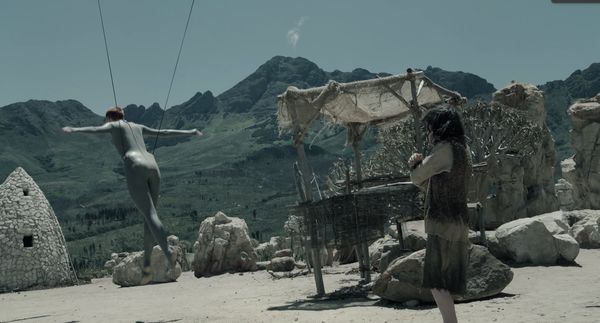
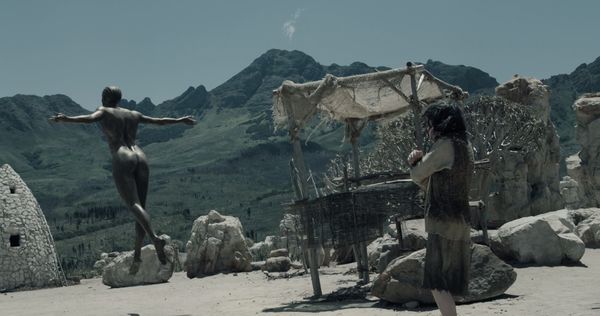
The Set Dec folks began collecting items for that setting, similar to what was found at the Ark wreckage, with some differences. "We added a lot of debris and burnt-out cars and twisted, broken metal," Christien states. "Your classic dystopian genre, post-war zone — or just war zone elements, such as a crashed helicopter and some androids. It was really taking the devastation to the next level, as if it's completely war-torn. A lot of burn marks and scorched walls," and plenty of "SOL" graffiti.
Coming to work each day at the abbatoir was a welcome, yet unique, change from the daily work at Lourensford. "I loved the fact that, as you walk in from breakfast, with a cake and some sandwich in your hand with a cup of coffee, that there was a transformative effect," Luke recalls. "It's just strange — there's dead bodies and all sorts of little details, which are great fun. But it transforms you as you walk through it — which is really important."
Still, the most iconic image of Raised by Wolves is Mother in her original form — as a Necromancer. "They were developed on Earth by the MIthraics, essentially as a superweapon which could be used to force people to convert to their religion," explains Guzikowski. "So they were built to instill terror — not to wipe out everyone, but to use to turn the world Mithraic." Necromancers are indeed all female, in connection with something within their Scriptures, in which they had apparently discovered, sometime in the 21st century, blueprints for their technology. "They didn't fully understand them, but were able to follow the design and put these things together and make them work."
When she feels the need, Mother inserts her original eyes, kept in a sack around her neck, and turns from her warm, gray-suited self into the bronze figure of her other self, before rising up into the air to go in for an attack. ["We always joked that she keeps her balls around her neck," laughs Luke.] Her design evolved but was rooted in something Scott had in the back of his mind. "Ridley loves the Art Deco aesthetic of the Atlas statue in front of Rockefeller Center," Guzikowski explains. "He envisioned this female version, this floating god/nightmare bronzed killing machine." Adds Zucker, "He liked how formidable it was, and really wanted to render that in a more active form." Scott drew her beautifully simple face, a departure from the commonly complex designs one would typically see in sci fi — and much like the robot seen in Fritz Lang's silent classic, Metropolis. Her cruciform-like pose when in the air also came from Scott, complete with Christ-like crossed feet.
Most amazing is her flying movement — or, as Guzikowski is quick to point out — levitating. "That's how I always wrote it in the script. She's not like Superman, barreling through the air, in that horizontal position. She's more levitating, like a god." Adds McIntyre, "Ridley always described that she's a superhuman superpower superwhatever, so she does not have to jump to take off. She's not scared of anything. So all of her movement is especially deliberate."
Key to the success of the character's change from Mother to Necromancer are the transitions, as she steps into and out of the air — dependent both on the carefully designed rig created to accomplish the moves, as well as the perfect performance by actress Amanda Collin. "We had a stunt facility at Cape Town Film Studios," explains Eatock, "where we workshopped it and did our R & D. It's half a trapeze act. We asked ourselves, "Do we go with the normal angel, flying in and out rig? Or could we do something even more spectacular, to allow horizontal movement?'"
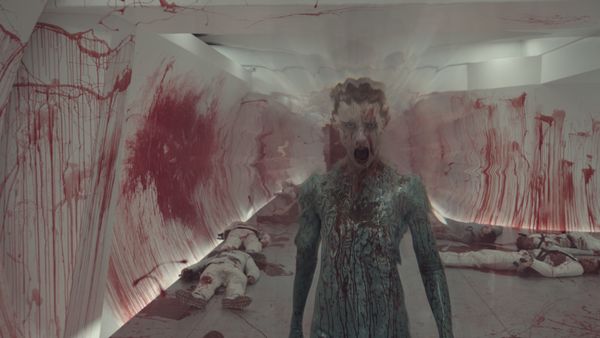
The resultant system is actually a cablecam rig, with four supports, suspending a cable system that allows not only up and down movement of the actress, but also horizontal movement — much like the cablecam systems used to photograph football games on television, which bring the camera just above, in the center of the field and follow the action. Collin had cables attached to her at several points, which were suspended from a T-bar above, connected to the cablecam's hoist motor. And what sells the movement is Collin's smooth flow as she steps on and off the ground, appearing to simply continue her walk from the air as she steps. Notes Zucker, "There's an elegance to it, even as it's intimidating."
It is also Collin's facial performance which drives vendor Mr. X's VFX animation. "We did a scan of Amanda and created a 3D model from that scan," McIntyre explains. "They then match moved not only her body movements, head and turns, but also her cheek movements, lips, eye movements and facial expressions and put those onto the Necromancer. But those are actually Amanda's eyes, with some color manipulation, in the CG model. That's her."
What makes the Necromancer the deadly weapon that she is, though, is the sound she emits, which causes her targets, living creatures like humans, to explode — or "eviscerate," the term Scott used. That "death scream," as its designer Jamey Scott calls it, was originally derived from a sound the picture editorial team had inserted temporarily, which became popular with the producers. "I never got the story on what that sound actually was or where it came from, but it was reminiscent of a peacock call that had a bending tonal shape to it. So I started with that and iterated on that as the basis for my design." He tried hiring some voice actors to emulate it, with varying degrees of success, but eventually ended up doing something with his own voice, tweaking the pitch envelope and building layers. Its piercing sound can only be described one way: "It's VERY LOUD," says re-recording engineer Russ Smith.
To give it specific impact and elicit the greatest reaction while filming, Scott actually insisted the Death Scream be played aloud on set, while shooting scenes of her victims, moments before they explode. "They had a PA system — a big one — and the director could cue it," notes cinematographer Erik Messerschmidt, who shot three episodes. "One of the sound team would play it — and they had it LOUD. But it was very effective for eliciting the best performance, far more than someone just saying, 'Now!'"
Raised by Wolves is a dark tale of quintessential science fiction, with every element a sci fi can would ever want — with enough twists from the mind of Aaron Guzikowski (whom, Luke Scott notes, "Let's be clear — Aaron is a sick man. . . ") and built around Ridley Scott's own visual aesthetic. Says the writer, "Ridley is able to, in a painterly way, treat all of the variances you encounter and link it all together in this one palette. At the end of the day, it really sucks you in in a way that just lets you feel like you're somewhere else."
